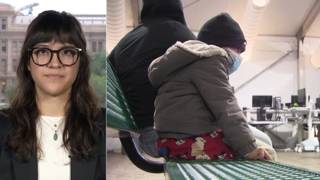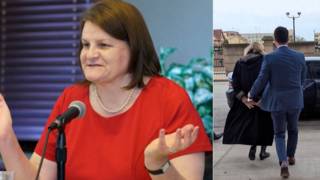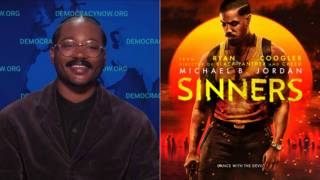
Topics
Guests
- Patrick Cockburnjournalist with the London Independent and author of the new book, The Occupation: War and Resistance in Iraq. He joins us on the phone from Amman, Jordan, where he has just arrived from Baghdad.
- Dr. Amer Majeedan Iraqi doctor at Al Sadr hospital in Najaf. He has treated some of the injured from the battle in Najaf. He is being translated by his cousin, Sami Rasouli.
There are new doubts about the U.S. and Iraqi claim that the hundreds of people killed in a battle in Najaf over the weekend were members of a messianic cult. Reports indicate the official story might actually be a cover-up for a massacre. We speak with London Independent correspondent Patrick Cockburn and Dr. Amer Majeed, a doctor who treated the wounded. [includes rush transcript]
Transcript
JUAN GONZALEZ: There are new doubts about the U.S. and Iraqi claim that the hundreds of people killed in a battle in Najaf over the weekend were members of a messianic cult. Journalist Patrick Cockburn of the London Independent reports the official story might actually be a cover-up for a massacre.
AMY GOODMAN: Patrick Cockburn is author of the new book, The Occupation: War and Resistance in Iraq. He has just left Iraq and joins us on the phone from Amman, Jordan. Patrick, welcome to Democracy Now! What did you learn about what happened in Najaf?
PATRICK COCKBURN: It’s a very confused situation. One of the really amazing things about it is that this is one of the greatest uses of U.S. air power for two-and-a-half years since the battle for Fallujah, and we don’t quite know who was under attack, although some 300 people were killed. It appears that there was a battle there with a sect that was disliked by the local government in Najaf, but also that a tribe, pilgrims who were marching through the area, also came under attack and suffered heavy losses. All in all, it’s a very confused situation.
JUAN GONZALEZ: And the sect was a Shia sect that was from another part of the country going on pilgrimage?
PATRICK COCKBURN: No. That’s not — I mean, there are allegations flying backwards and forwards at the moment, but there’s no real evidence for this. I mean, the commonsense explanation, the explanation that, as some people there give, is that there was a tribe called the Al-Hawatim, who were going on pilgrimage — this is a great Shia ritual this week, the Ashura — and about 200 of them were walking, which is very common in Iraq. Over this last week, millions of people have been walking the roads on pilgrimage. And they got mixed up in this battle. Their tribal leader was ill. He and his wife were in a car. When they came to a checkpoint, the soldiers at checkpoint opened fire, killed them both. And then the other tribesmen attacked the checkpoint. It seems to me likely that the pilgrims got involved in a battle that was already going on between the government of Najaf and this sect, which they much disliked, which had a camp just outside Najaf.
AMY GOODMAN: Patrick Cockburn, what was the role of the U.S.? A helicopter got shot down.
PATRICK COCKBURN: A helicopter got shot down. There was heavy bombing. And that seems to explain the very heavy casualties of the people there: upwards of 300 killed, many wounded. Only 11 Iraqi soldiers were killed, and 27 wounded. So the casualties are very one-sided. So the key to this battle seems to be very heavy use of U.S. air power. But it’s still unclear who the victims were on the ground.
JUAN GONZALEZ: Of course, the initial reports here in the U.S. press have been that this was a calculated and premeditated attack on a large scale. So this scenario would directly contradict those reports.
PATRICK COCKBURN: Yes. And I think it’s very difficult to maintain the theory that there was this bunch of conspirators that were about to attack Najaf and murder all the religious leaders there. The governor of Najaf, Asaad Abu Gilel, has actually said now that he — his council had a convened secret meeting and made a decision to attack people who he describes as outlaws. So, even those who carried out the attack are no longer insisting that they discovered a conspiracy at the last minute and they were able to nip it in the bud. They’ve completely changed their story.
AMY GOODMAN: Patrick Cockburn, we want to bring into this discussion Dr. Amer Majeed. He’s an Iraqi doctor at Al Sadr hospital in Najaf. He has treated some of the injured from this attack. He is being translated by his cousin, Sami Rasouli. Dr. Majeed, what did you see in the hospital? What do you understand happened?
DR. AMER MAJEED: [translated] On the 27th of January, early in the morning, which is the seventh of Ashura, we were at home before I went to work. We heard heavy bombing repeatedly, and also we heard an air force, the U.S. Air Force, flying over the house. I called somebody that I know working in the security police in Najaf. I was told that there were some tourists in Al-Zarqa area, which is about 10 kilometers far from the center of the city of Najaf. And he was rushed to close the line, hang up.
At 8:00 p.m., I went to the hospital as usual to work. I noticed right away preparations to receive injured and casualties from the fighting. About 10:00 p.m., we received injured individuals from the police and also the Iraqi National Guard.
During the treatment of the injured, I was able to ask one of them about what happened. He said — the individual — that after midnight we received information there are some armed individuals, fighters in the Al-Zarqa area, and they intended to come to Najaf during the tenth of Ashura and assault the religious figures in the town. When some of us tried to go there and fight them back, while we were facing them, we were under heavy attack, heavy fire. And it was a different and new arsenal of weapons. There were numbers of Iraqi National Guards and security police got injured and killed. And a major of six stars was injured, who was leading our group. Then, we were ordered to withdraw, and the U.S. Air Force was called upon to come and help.
JUAN GONZALEZ: Doctor, were you able to ascertain, obviously, from the victims how many civilians — what percentage may have been civilians who were injured in this conflict?
DR. AMER MAJEED: [translated] There are big numbers of civilians who got caught in this fight and got killed. There were many, many families who were in that area with the fighters. Those individuals, the family members, were brought into the hospital, and they were humanely treated.
AMY GOODMAN: Women and children?
DR. AMER MAJEED: [translated] Some of the children, not a big number. They were accompanied with their families.
AMY GOODMAN: And women?
SAMI RASOULI: Would you speak up, please?
AMY GOODMAN: And women, Sami?
DR. AMER MAJEED: [translated] Yes. Yes.
AMY GOODMAN: Well, Dr. Amer Majeed, I want to thank you for being with us; Sami Rasouli, for translating, Iraqi American currently back living in Najaf; and Patrick Cockburn, journalist with the London Independent.













Media Options